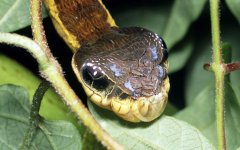cyb said:
~ If it is a random mutation..why is it that it occurs many times, across many class/genus/species?
(when does random...cross the line to become common?)
The reason why it occurs many times is because most predators (animals in general) use their eyes to hunt
so this mutation is bound to pop up here and there. Same as real eyes have been developed
independently for at least 20 times (probably more) because in a world which spends a lot
of it's time in light, eyes (photo sensitive cells) are bound to give you an edge.
cyb said:
~ How long has this phenomenon existed in Evo time scales? Recently emerged or manifest over immeasurable generations?
I'd say both since this eye pattern have not evolved from one species but across several different ones. Animals should at least have evolved eyes for this pattern to emerge though.
cyb said:
~ If this has been manifesting for a long time (aeons)...why has it not become dominant and overruled the non-specular spots? (both co-exist today)
Just because you think it would be the most successful pattern against predation doesn't mean it
is true for every environment on this planet.
Also, if you give enough time the animals without the highlight might also develop a highlight...or maybe get
rid of the eye completely because that's more successful.
cyb said:
~ Also specular optics, whilst obviously being perceptible by a creature, would not be 'understood as photonic' by it's (limited) neural lexicon. So it could not choose to adopt this mutation as 'better' (evo goes random again)
If not random, then something knows about optics...
(I've worked in high end fibre optics and spectral analysis...it's incredibly complex):surprised
I'm not sure if I understand what you mean.
You seem to make this more complex than it really is. No one needs to know anythig about optics.
There is no conscious choice of neither predator nor pray as to which design is better to keep.
In the case of butterflies and owl it's all about what design is most successful in scaring of the owl.
The owl thinks, lunch or it thinks, Whoa! I'm outta here.
cyb said:
~ The particular highlight on the Owl Butterflies wing is crescent shaped, not a simple white spot as in some others. this denotes a highlight that can only have come from an acute angle off a convex surface...this strikes me as very determined and not random at all (but that's just me.)
I think it has been answered above and also earlier in this thread.
Simple white spots can develop into crescents over time because they are a minuscule % less
likely to be eaten by some predators and thus passing of it's genes that looks more like a crescent.
I think time is the answer.
Butterfly scaring of predator
A terrifying encounter with a butterfly sends a wood mouse packing.

www.bbc.co.uk
Some eyes might have started as a mating preference or is completely driven by mating behaviour
but in the case of most butterflies it seems to mainly be used
as warding of predators.
From what I know butterflies have rather primitive eyesight and mainly use pheromones for mating.
EDIT: "Whether one considers the eye to have evolved once or multiple times depends somewhat on the definition of an eye"

en.wikipedia.org







